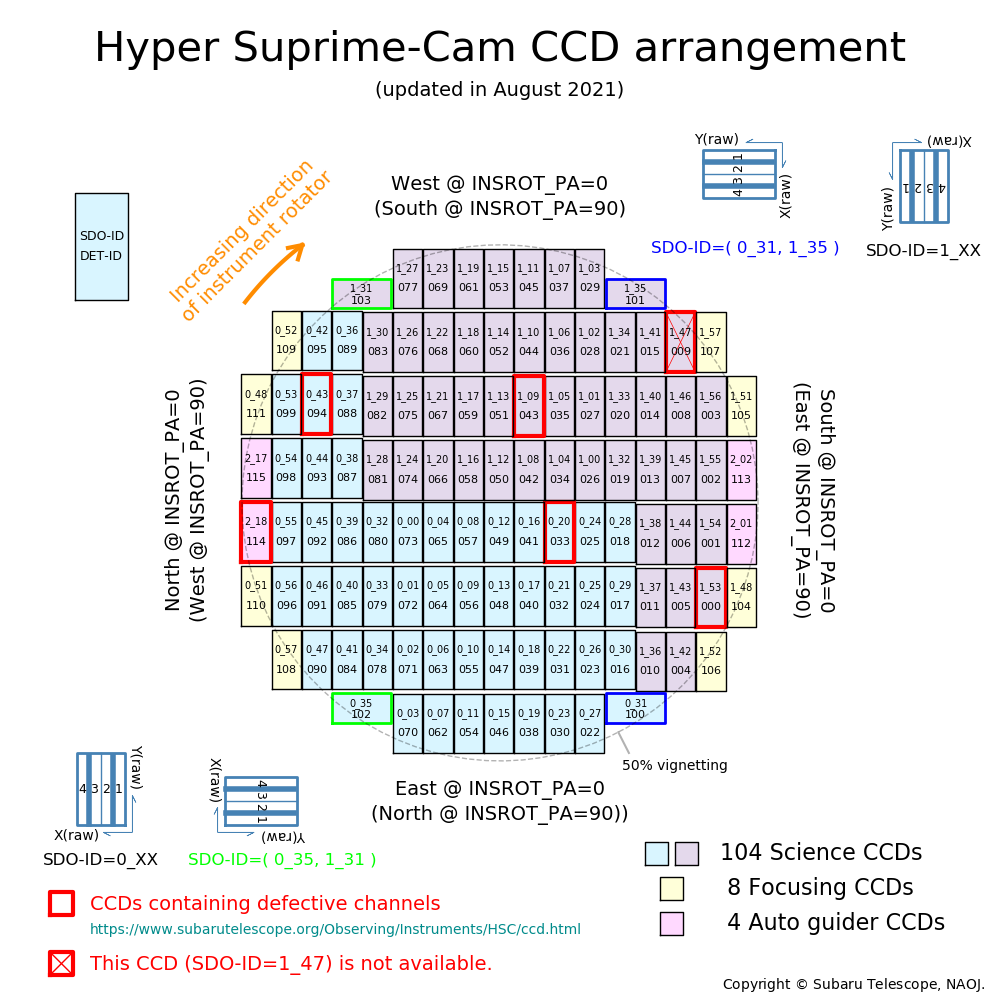HSC basic information¶
HSC (Hyper Suprime-Cam) is a prime focus camera for Subaru telescope. It uses 104 main science CCDs, which covers 1.8 degree square FoV. This page provides the information of HSC CCD, filters, file naming rules for raw data and the amount of data. Please refer Subaru Telescope - HSC for more information.
HSC CCDs¶
HSC has 116 CCDs in total; 104 for science use, 8 for auto focus, and 4 for auto guider. The CCD data except 4 auto guider CCDs are output as raw data. The specific ID used for raw data of each CCD is SDO-ID in figure 1. DET-ID in the figure is used in hscPipe processing. The naming rule of raw data is described in Naming rules of raw data.

Figure 1:CCD arrangement (excerpting from HSC page on the Subaru telescope web site)¶
Figure 2 shows the structure of each CCD. One CCD consists of 4 channel (CH)s and each has 536 x 4241 pixels, then total 2144 x 4241 pixels (in the raw data format). Each CH has also overscan, blank, and non-science use regions. After detrending, the size of 1 CCD becomes 2048 x 4176 pixels.

Figure 2:Format of 1 CCD¶
HSC filters¶
The information of five broad-band (g-, r2-, i2-, z-, y-band), one intermediate-band (IB945), 18 narrow-band filters (NB387, NB391, NB395, NB400, NB430, NB468, NB497, NB506, NB515, NB527, NB656, NB718, NB816, NB872, NB921, NB926, NB973, NB1010), and one extended broadband filter (EB-gri) are publicly available.
You can obtain the filter response curves from here , where the following effects are included.
Atmosphere (assuming airmass=1.2, PWV=1.5mm, Maunakea)
Primary mirror reflectivity
Transmittance of the Primary Focus Unit of the HSC
Transmittance of the dewar window
Quantum efficiency of CCD
Vignetting (factor x0.83)
The original throughput data of the individual components can be chacked here Figure 3 shows filter transmission characteristics.

Figure 3:The transmission curves of in-service filters. The red curves correpsond to the original throughputs. The black curves are the throughputs where the various effects (atomosphere, primary mirror, PFU, dewer window, QE, and vignetting) are included. The both types of the response curves are based on the area-weighted mean measurements.¶
All the above filters are set in hscpipe 8.4 and 8.5.3 in the Large-scale data analysis system (LSC) , and hscpipe 8.5.3 in the Multi-wavelength Data Analysis System (MDAS) . However, if you use the others, NB391, NB395, NB430, NB497, and NB506 are not available. In this case, please run “patch file” to increase NB filters following the instruction in Increase used filters . This corresponds to manually set “config file” following the instruction in For filters without color term in hscpipe . |
Naming rules of raw data¶
The format of observed raw data is HSC+[A,B,C,…]+%6d+%2d.fits. Now we use HSCAxxxxxxyy.fits, but it will be HSCB, HSCC, and so on in the future. The next ‘%6d’ indicates the shot number (in hscPipe it is called “visit”) and ‘%2d’ CCD discrimination number. For the shot number, the continuous even and odd number are assigned. For example, both HSCA018200yy.fits and HSCA018201yy.fits are the data of one shot. CCD discrimination number is from 00 to 57.
CCDs colored in cyan and purple in figure 1 denote CCDs with even and odd ‘%6d’ shot names, respectively. The double-digit number after under-bar on each CCD stands for a CCD discrimination number of raw data.
For instance, if you find a raw data named HSCA02234904.fits, its shot number (=visit) should be 22348, CCD discrimination number 04 (1_04 in figure 1), and CCD ID used in hscPipe processing 34.
Data amount¶
One pixel of HSC raw data stores 16 bit integer. Then one CCD has a data size of ~18MB. As the number of CCDs is 112, the total amount of raw data in one shot becomes ~2GB. After hscPipe processing, each pixel has 32-bit data as well as a 32-bit image and a 16-bit flag image. Finally, one pixel of the reduced image stores 80 bit. The following table shows the data amount generated in each step.
Data |
amount |
|---|---|
1 CCD of raw data |
18 MB |
1 shot of raw data |
2 GB (112 CCDs) |
1 CCD of reduced data |
82 MB |
1 shot of reduced data |
11 GB (104 CCDs) |
1 CCD’s catalog |
~10MB - 30MB |
1 shot’s catalog |
1-2 GB |
1 CCD(raw + reduced + catalog) |
100 MB |
1 shot(raw + reduced + catalog) |
13 GB |
If you took 100 shots per one object, the final size of data will be over 1 TB.
